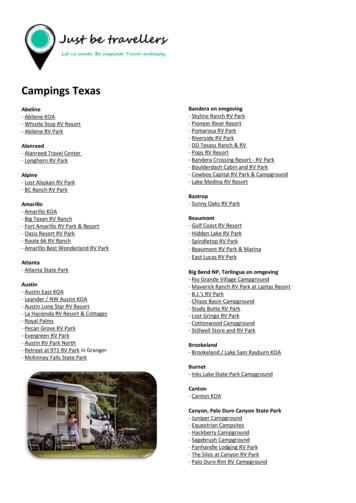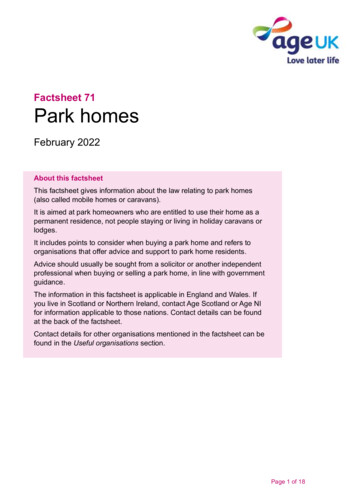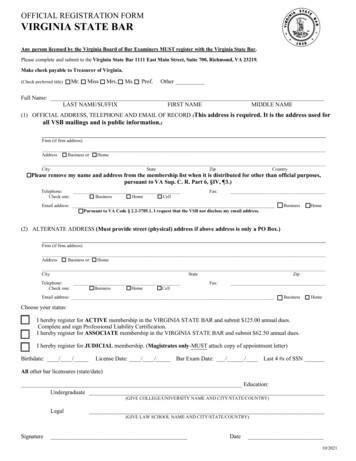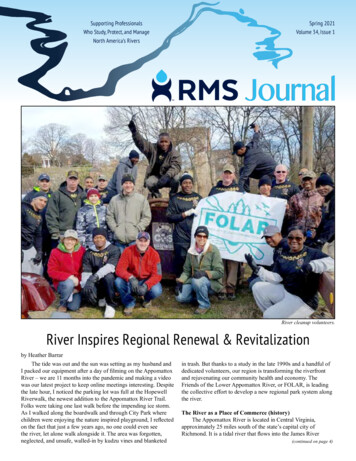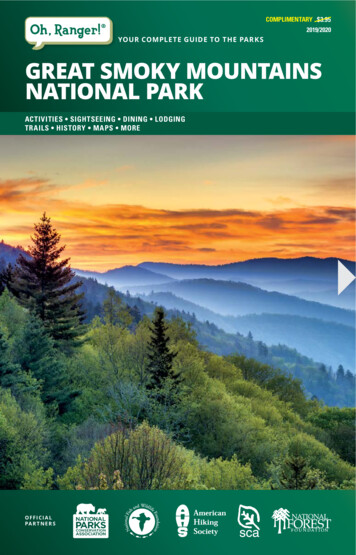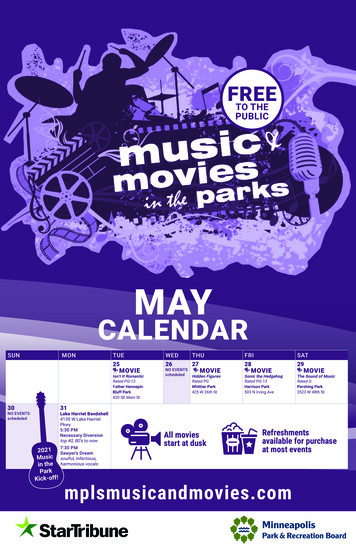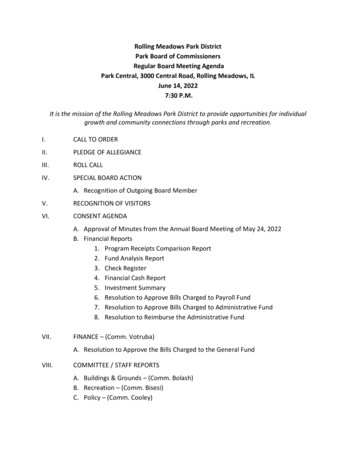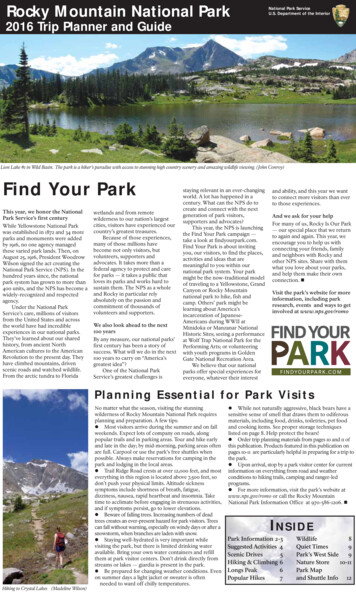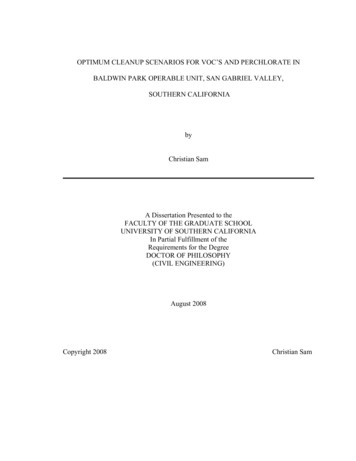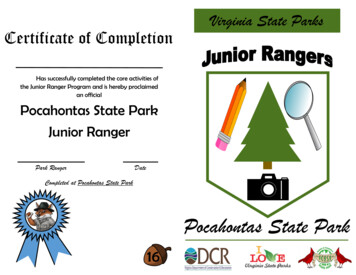
Transcription
Certificate of CompletionVirginia State ParksHas successfully completed the core activities ofthe Junior Ranger Program and is hereby proclaimedan officialPocahontas State ParkJunior RangerPark RangerDateCompleted at Pocahontas State ParkPocahontas State Park16
Additional Park ActivitiesDear ParentsWIelcome to Pocahontas State Park’s Junior Ranger Program!n addition to completing the activities in this book, we’d like for youtry one activity from each category below and tell us of youradventures!Ranger Led Activities:Thank you for your interest in assisting your child to become aPocahontas State Park Junior Ranger. We are pleased that you and yourfamily are interested in participating in our program. Discovering Virginia’snatural, cultural and historical resources together can create unforgettablememories for you and your family. We are delighted to share our park withyou.Deep in the heart of a thick forest in Chesterfield County,Pocahontas State Park is 7,950 acres— the largest Virginia State Park. Thepark is one of Virginia’s more popular state parks, and offers a variety ofoutdoor activities, including biking, hiking, picnicking , swimming, campingand family-friendly nature programs. Swift Creek Lake and Beaver Lakegive visitors a chance for excellent wildlife viewing and fishing.Pocahontas State Park’s Junior Ranger activities are designed toassist you and your child to become more familiar with the plants andanimals of Pocahontas State Park and the local Piedmont region of Virginia.There is so much to discover! While the activities in this book are self-guided,there are many programs and camps offered to enhance your Junior Rangerexperience. Please check out the Pocahontas State Park events on the Virginia State Park events website. Our hope is this program will foster a lifelong interest in your natural surroundings. The mission of Virginia State Parksis “to conserve natural, scenic, historic, and cultural resources of thecommonwealth and to provide recreational and educational opportunitiesconsistent with good stewardship of these lands, waters, and facilities thatleaves them unimpaired for future generations.” Attend a program:Title:Date: Visit the Nature and Discovery CentersHistory: Visit the CCC Field/ Hall/ Memorial Garden Hike a new trail (one you’ve never been on) Observe bluebirds at their boxes (from a safe distance please)Visit the gravesite along Forest Exploration TrailVisit the Front FieldRecreation:Rent a boat (seasonal) - Explore Swift Creek LakeTry your hand at Mountain Biking/ Fishing/ or GeocachingWildlife:Find tracks along the lakeSit in one spot for some time and observe what you see/hear/and smellWhat was your favorite activity? Why?We would love to hear any comments about your Junior Rangerexperiences. Have fun!Sincerely,The Staff at PocahontasPocahontas State Park10301 State Park RoadChesterfield, VA 23832804-796-42552Congratulations on completing thePocahontas State Park Junior RangerProgram!15
Ask A RangerEver wonder what a day in the life of a park ranger is like?Now is your chance to find out! Find a park ranger and askhim or her these quick questions to find out more. Then comeup with a few questions of your own! Is there anything you’vealways wanted to Ask a Ranger?Welcome to the Pocahontas State ParkJunior Ranger ProgramPocahontas State Park is rich with natural, cultural, andrecreational resources! You will have a close up experience with nature asyou discover Pocahontas State Park’s fascinating history and enjoy thepark’s many outdoor recreational activities.What’s your name?How to become a Junior RangerWhat’s your job at the park?Using this activity book as your guide, complete the activities foryour age level. Have a parent or guardian initial each activity completed,Only one level may be completed at a time. In addition to theseself-guided activities, we hope you’ll be able to participate in Ranger ledprogramming available at parks throughout the state. Their scheduledactivities are listed on the Virginia State Parks’ event website and includeguided hikes, nature programs, Junior Ranger specific events and summerday camps. When you have completed all requirements, show youractivity pages to a park employee to receive your Junior Ranger badge.What’s your favorite part of your job?Do you get to live in the park?What tools or equipment do you use inyour job?What is the coolest thing you’ve seen atthe park?Do you have a favorite spot in the park?Level 1: suggested for youth ages 5-6 years oldWhat do the patches on your uniformmean?Level 2: suggested for youth ages 7-9 years oldLevel 3: suggested for youth ages 10-11 years old(Now ask your own question)1)2)3)4)5)14As a Junior Ranger, I pledge to: Preserve and protect ourparks Care for my natural and historical surroundings Share what I have learnedwith others Obey all safety rules Continue to EXPLORE andDISCOVER!3
Safety FirstJFauna Forageunior Rangers need to be aware of potential dangers when exploringoutdoors. To meet the requirement for this Junior Ranger activity, readthis page very carefully.Poison Ivy:Poison Ivy is commonly found in PocahontasState Park’s forested areas . It can be found growingalong the ground or up a tree trunk as a hairy vine. Eachleaf id made up o 3 leaflets, which may have smooth ornotched edges. Some people develop skin irritations whenthey come in contact with this plant. The berries frompoison ivy are an important food source for wildlife. Findand identify poison ivy, but do not touch it.Ticks:Deer TickThe most common species of tick in Virginia include the American DogTick, Lone Star Tick, Brown Dog Tick, and Deer Tick. The followingmethods of tick bite prevention are recommended by the VirginiaDepartment of Health. Avoid tick infested areas such as tall grass and dense vegetation Wear light colored clothing so ticks can be found easilyWalk in the center of trails and avoid brushing against weedsand tall grassLone Star TickTuck pant legs into socks so ticks stay on the outside of pantsConduct tick checks on children and pets every 4 hoursUse tick repellents that contain at least 30% DEETTicks are best removed with tweezers or by wrapping the tick in tissuepaper and pulling our with fingers. Do not twist or jerk, and pull awayslowly to avoid leaving the mouthparts in the wound . Do not use nailpolish, petroleum jelly, alcohol, or hot matches to remove the tick.Wash the wound with an antiseptic after the tick is removed. Kill thetick in rubbing alcohol and keep it in a small vial for a few months incase any disease symptoms develop.American Dog TickSnakes:Snakes have a very important role in the local food web.They are carnivores, meaning they eat other animals. Most ofthe snakes in Virginia are not venomous. There are 3 venomous snakes found in Virginia, but only the Northern Copperhead has been found within Pocahontas State Park. Asnake’s most common from of defense is avoidance, so givethem room to flee. Watch where you are stepping andNorthern Copperhead never blindly reach under rocks or into openings.4Level ToadVentLevel LizardPollywogReptileTerrapinTortoiseTree FrogTurtleVentralLevel rmeableSalamanderTypanumVenomousViviparous13
Park ActivitiesConstellationsHave you ever gazed up at the night sky and swore you sawsome sort of animal or shape? Well, what you saw is what isknown as a constellation, or a grouping of stars that makesome shape. Ever heard of the Big Dipper? That’s aconstellation! The Big Dipper is actually part of Ursa Major,or a group of stars which make the rough shape of a mamabear. In fact, the legend of the Great Bear traces its originsback hundreds, if not thousands of years to NativeAmerican tribes such as the Iroquois. Although the BigDipper is well known, there are numerous constellationscovering the night sky! Now that you know a little aboutconstellations, let’s try to make some of our own.What's your constellation story?12Whether you are visiting Pocahontas State Park for thefirst time or for the tenth time, one of the best ways todiscover all of the park’s treasures is to take a look atthe park map! So let’s take a look at some importantmap features:Legend: This helps you figure out what allthose little pictures mean . Want to findthe playground? This helps you figure outwhat symbol to look for on the map.You can usually pick up a park map at thepark office, visitor's center, or self pay station.Or you can have an adult help you print amap from www.virigninastateparks.gov. Seeif you can use the park map to answer thesequestions:Scale: This helps you measuredistance on the map. Eachmap will have its own scale.Trail List: This will give you importantinformation about all of the park’strails; including how long the trail isand if it is easy or hardWhat is the longest trail in the park? How long is it?How many Picnic Shelters are there? How many restrooms?Where is a good place to spot some wildlife?Does the park have a playground? Circle it on the map.What does the symbol for Parking look like? Draw it:5
What Made That?PBird Identificationocahontas State Park is home to numerous animals of all shapesand sizes, but one thing they all have in common is that they leavetracks. Have you ever noticed that when you walk around in mudor sand you leave a shoe print or footprint behind? Animals do thatsame thing! Try your hand at identifying some tracks of the park’sfurry friends.Bird watching is a wonderful way to get outdoors and be active. Like ascavenger hunt that you can do anywhere, bird watching challenges you touse your senses to find and identify your feathered friends. Virginia is hometo over 400 different species of birds. Some live here year-round, some forjust a season, and a few only stop for a rest on their migratory journeys. Allyou need to do is find a friend, a pair of binoculars, an identification fieldguide, and your sense of adventure.Level 1: Observe 1 habitat, describe 1 bird and its behavior.Level 2: Observe 2 habitats, describe 2 birds and their behavior, Identify a bird by the description and behavior.White TailDeerLevel 3: Observe 3 habitats, describe 3 birds and their behaviors, Identify 3 birds by thedescription and behaviorHabitats:RacoonBird can be found just about everywhere in thewild, but every bird has a habitat they prefer.Knowing what kind of habitat a particular birdlikes, you can almost predict where that bird willbe. There are six common habitats where youcan find a bird. As you visit each habitat, check itoff the list :OpossumBackyardLakes/ PondsOpen Field/Meadow Wetlands (Swamps)Black BearForestBeachesBehavior and Description:Besides knowing what habitat you are in, watching the bird’s behavior can help you identify thespecies. Every avian species has a different shape, size, color, song, and behavior. Some birds, likeSparrows, can be found kicking through leaves to find food. Using the lines below, or a separatesheet of paper, describe the habitat, behavior , and birds you see.SquirrelBobcatTurkeyDraw your bird here:Coyote611
Leaf Key ContinuedCivilian Conservation Corp13.A) 7 to 9 leaflets; nuts with thick, splitting husks; large buds; tight interlacing ridged bark— MockernutHickory (Carya alba)B) 7 o 11 leaflets; nuts with thin, partially splitting husks; buds sulfer yellow— Butternut Hickory (Caryacordiformis)14.A) Leaves lobed with or without teeth or large rounded teeth appearing wavy, GO TO 15.B) Leaves are not lobed, but may not be toothed or spined, GO TO 21.15.A) Leaves are palmately veine, and toothed, GO TO 16.B) Leaves are pinnately veined, GO TO 17.16.A) Leaves 5 to 8 inches long and wide, with 3 to 5 large lobes, triangular and irregular teeth. Seeds in abumpy ball— Sycamore (Plananus occidentalis)B) Leaves star-shaped, with 5 to 7 lobes, very finely toothed. Seeds in a spiky ball— Sweetgum(Liquidambar styraciflua).17.A) Leaves with 4 to 6 lobes and tulip like shape. Buds “duckbill” shaped. Bark light gray and furrowedlengthwise—Yellow Poplar (Liriodendron tulipifera)B) Leaves are not tulip shaped, buds not duckbill shaped, GO TO 18.18.19.20.From1935-1946 theCCC built theSwift CreekRecreationalDemonstrationArea, which in1946 becamePocahontasState Park .A) Leaf margin with very large rounded teeth, appearing wavy, GO TO 19.B) At least some of the leaves are deeply lobed, GO TO 20.A) Leaves 4 to 8 inches long, bark with wide, coarse, deep furrows. Found mostly on ridge tops and dryslopes from Piedmont west— Chestnut Oak (Quercus prinus).B) Leaves 5 to 8 inches long, margin wavy or appearing widely toothed. Bark light gray and scaly.Found on flooded and moist soil from Piedmont east— Swamp Chestnut Oak (Quercus maichauxii)A) Leaves have 2 lobes (mitten shaped), or three lobes (turkey foot shaped), or no lobes, leaves havespicy/ sweet odor when crushed— Sassafras (Sassafras albidum).B) Leaf with 7 to 9 lobes, deep sinuses, acorn cap cover 1/4 of nut. Bark very light gray, in loose plates—White Oak (Quercus alba).21.A) The leaf margin is toothed or spiny; teeth may be widely spaced or very thin, GO TO 22B) Leaf edge is not toothed or spiny, GO TO 23.22.A) Twigs have 2-3 corky “wings”, and bark of trunk is corky, leaf smooth above and hairy below, foundin southeastern Virginia— Winged Elm (Ulmus alata).B) Twigs do not have corky wings; leaves rough and sandpapery on underside but smooth on top, whiteand reddish brown layers in cross section of bark— American Elm (Ulmus americana).23.About theCCCA) Tree found in standing water, swamp edge, or moist low woods; leaves thick and leathery, undersideof leaf white, twigs greenish. Usually under 20 feet tall and 4 inch diameter. Crushed leaves have sweetsmell— Sweetbay (Magnolia virginiana).B) Three not necessarily found near water, leaves heart shaped, pink or purple flowers in spring— EasterRedbud (Cercis canadensis)10The CCC builtcabin camps,dams, lakes,and bridges inthe park many ofwhich are stillin use today!Join The CCC!Now its timefor you to signup. Fill out thisspecialapplication.(Levels 2 and 3)Application For Enrollmentin theCivilian Conservation CorpsFor Official UseDate:Local Agency: Swift Creek RDACity or Town:What is your name?Do you live on a farm?How tall are you?How much do you weigh?How old are you?Are you married?Are you a US citizen?Are you male or female?Are you employed?How much do you earn/week?How may years of schooling do you have?How many brothers andsisters do you have?What do your father andmother do?How many rooms are inyour home?Do you have running water?Do you have an ice box?Do you have a telephone?7
Native TreesTLeaf Keyrees are very important to us and the wildlife that use them forshelter and food. People use trees to build homes and furnitureand make products like crayons, paper, pencils, newspapers,and more. We also use leaves and fruit for spices and food.Having trees in your yard can help reduce energy bills in thesummer because of the shade they provide.Knowing how to identify different kinds of trees by carefullyinvestigating their leaves growth patterns, bark, fruit, and flowers is avery valuable skill. This Junior Ranger activity will help you developinvestigation skills to identify trees at Pocahontas State Park and athome!Level 1: Using the leaf guide below, identify at least 4 trees inthe park. Circle the illustration of the trees you identifyLevel 2: Using the leaf guide below, identify at least 6 trees inthe park. Circle the illustration of the trees you identify1.A) Leaves are needle or scale like, GO TO 2.B) Leaves are broad and flat, GO TO 4.2.A) Needles at least 1 inch long, GO TO 3.B) Needles less than 1 inch long or scale like, Eastern Redcedar ( Juniperus virginianus)3.A) Needles in groups of 5, and 3 to 5 inches long— Eastern White Pine (Pinus strobus)B) Needles in groups of 2 or 3, and 6 to 9 inches long— Loblolly Pine (Pinus taeda)4.A) Leaves opposite of each other, GO TO 5B) Leaves alternate of each other, GO TO 8.5.A) Leaves compound, GO TO 6B) Leaves simple, GO TO 146.A) Leaflets toothed from midway up edge to tip, and underside covered with whitish wax—White ash(Fraxinus americana )B) Leaflets toothed from base to tip and fuzzy underneath; often found near water—Green ash(Fraxinus pennsylvanica)7.A) leave not lobed— Leaves less than 6 inch long, edges not lobed or toothed and leaves fall off aftergrowing season, bark blocky— Flowering Dogwood (Cornus florida)B) leaves lobed— Leaves have 3 to 5 lobes with shallow sinuses, and leaf veins in a hand pattern—RedMaples (Acer rubrum)8.A) leaves compound, GO TO 9.B) leaves simple, GO TO 11.9.A) Leaflets oval or oblong and less than 2 inches long, twigs have thorns, GO TO 10.B) Twigs do not have thorns, GO TO 11.10.A) Leaves singly compound, thorns in pairs on either side of buds, leaflet edge not toothed, deeplyfurrowed bark, and seed pods 2 to 5 inches long— Black Locust (Robinia pseudoacacia)B) Leaves singly or doubly compound, leaflet 1/2 to 1 1/2 inches long and edge may be toothed, 2 to 4inch thorns may be branched, and seed pods 8 to 12 inches long—Honeylocust (Gleditisa tricanthos).11.A) Leaves with 11 or more leaflets, GO TO 12.B) Leaves with less than 11 leaflets, GO TO 13.12.A) Leaves with 13 to 41 leaflets with just 2-4 teeth at the base, foul smell when bruised. Terminal leafletpresent, bark rough, but not furrowed— INVASIVE Tree-of-heaven (Ailanthus altissima)B) Leaves with 14 to 24 leaflets— Black Walnut (Juglans nigra)Level 3: Using the leaf guide below, identify at least 8 trees inthe park.Continue on the next page89
Lone Star Tick American Dog Tick Snakes: Snakes have a very important role in the local food web. They are carnivores, meaning they eat other animals. Most of the snakes in Virginia are not venomous. There are 3 venom-ous snakes found in Virginia, but only the Northern Copper-head has been found within Pocahontas State Park. A
